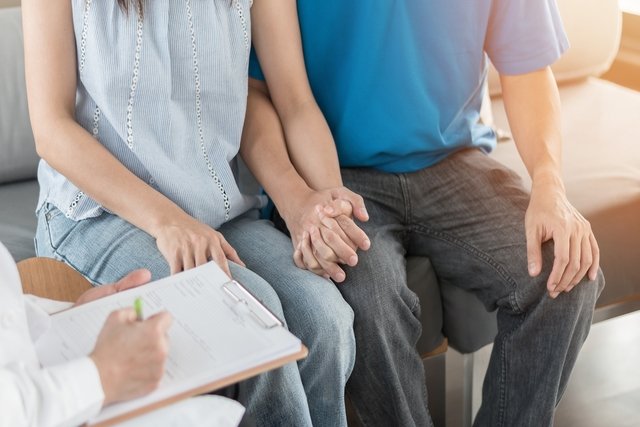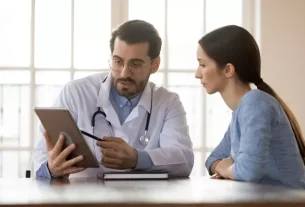HPV is a sexually transmitted infection (STI) caused by the human papillomavirus, which can affect women and men and does not cause symptoms at the beginning of the disease. However, in some cases, this infection can cause warts to appear in the genital region, anus, mouth or throat.
HPV is transmitted mainly through unprotected sexual intercourse, with or without penetration. Furthermore, despite being less common, this infection can also be transmitted from mother to baby during birth.
It is important that HPV infection is diagnosed by a general practitioner, gynecologist or urologist to begin treatment immediately, which is usually done with ointments and creams and procedures to remove warts. See how HPV treatment is carried out.

Main symptoms
Some symptoms that may appear during HPV are:
- Cauliflower-like warts on the anus, penis or vagina, which vary in number and size;
- Itchy warts;
- Skin-colored or reddish warts, which may bleed or have secretions;
- Warts on the lips, cheeks, tongue or throat;
- Burning or pain in the area of the warts.
However, HPV infection does not cause symptoms in most cases because warts can take months or years to appear. Learn about other symptoms of HPV.
Types of HPV
According to the location of the lesions, HPV can be classified into the following types:
- HPV genital: It can arise through unprotected sexual intercourse, whether penetrative or not. Lesions can appear on the scrotum, foreskin, glans or skin of the penis in men. In women, the lesions usually appear in the vagina and cervix;
- HPV on the bottle: Normally this type of HPV is caused by contact with lesions during unprotected oral sex, which can cause small white, red or skin-colored warts;
- HPV throat: This type of HPV can also appear as a result of unprotected oral sex, which can cause pain when swallowing, coughing or hoarseness;
- HPV in the groin: As well as in the genital region, this type of HPV can cause the appearance of warts that can itch, burn or bleed.
In addition, HPV can also affect the anus, nose, eyes or any other area of the body that has come into contact with the lesions.
How the diagnosis is made
The diagnosis of HPV must be made by a general practitioner, proctologist, gynecologist or urologist. To find out if a person has HPV, the doctor usually evaluates the signs and symptoms presented by the person and observes the warts.
In addition, the doctor may also request some tests, such as pap smears, peniscopy, serology and hybrid capture, a test that consists of taking small samples from the cervix to identify HPV. Find out about other tests that confirm the diagnosis of HPV.
HPV transmission
HPV transmission occurs mainly through unprotected sexual intercourse, whether through genital or oral contact, with penetration not being necessary.
Furthermore, despite being less common, HPV can also be transmitted from mother to baby during birth. See how HPV transmission happens.
What is the treatment like?
HPV treatment must be guided by a doctor and consists of eliminating the warts caused by the virus.
Thus, the main treatments recommended for HPV are:
- Ointments, creams or solutions: some creams, ointments or solutions, such as trichloroacetic acid, imiquimod and podophyllin may be recommended;
- Cervical cauterization: a treatment that burns lesions on the cervix, allowing the development of healthy cells;
- Cryotherapy: carried out in a doctor’s office, this is a procedure that consists of freezing the warts using liquid nitrogen, causing the lesions to “fall off”.
Surgery to remove warts may be indicated when the lesions are resistant to conventional treatments or when the degree of the lesions may increase the risk of cancer. Discover all the recommended treatments for HPV.
In addition, partners of people with HPV should also consult a doctor to check whether they also have the virus and, if necessary, start treatment.
Is HPV curable?
HPV can only be cured when the immune system is strengthened and can naturally fight and eliminate the virus. Understand better how HPV is cured.
Treatment with medication, surgery or cryotherapy can only eliminate warts caused by HPV, not combating the virus. Therefore, even if the lesions disappear, the virus is still present in the body and can be transmitted to other people.
How to prevent
To prevent HPV, it is important to use a condom in all sexual relations, as this makes it possible to avoid the transmission of not only HPV, but also other sexually transmitted infections.
It is important to note that condoms do not cover all areas that may have injuries, such as the scrotum, vulva and pubic region, for example. Therefore, in cases of infection in these regions, it is recommended to use a female condom, which covers the entire vulva, preventing transmission of the virus more effectively.
In addition, the Gardasil and Cervarix vaccines are also indicated to prevent infection with the HPV virus. These vaccines can be taken by children, adolescents and adults, at health centers or in private clinics. See when and how to get the HPV vaccine.
Possible complications
When lesions caused by HPV are not diagnosed and treated properly, this infection can cause complications such as cancer of the cervix, vagina, penis, mouth, throat or anus.
Furthermore, people who smoke, carry HIV or use medications that weaken the immune system are at greater risk of complications from HPV.

Sign up for our newsletter and stay up to date with exclusive news
that can transform your routine!
Warning: Undefined array key "title" in /home/storelat/public_html/wp-content/plugins/link-whisper-premium/templates/frontend/related-posts.php on line 12
Warning: Undefined array key "title_tag" in /home/storelat/public_html/wp-content/plugins/link-whisper-premium/templates/frontend/related-posts.php on line 13



